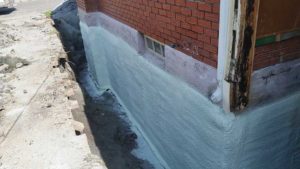HFO-blown spray foam to prevent air leakage, improve waterproofing

HFO-blown spray foam insulation, on the other hand, forms a continuous, airtight seal, preventing air leakage and maintaining a consistent indoor temperature. Spray foam provides a complete air barrier and unparalleled insulation values.
Canada’s neighbour, the U.S. Department of Energy (DOE) notes, when correctly installed, closed-cell spray foam insulation “can yield a higher R-value than traditional batt insulation for the same thickness, and can fill even the smallest cavities, creating an effective air barrier.”2
What makes an effective air barrier is not only defined by its ability to completely envelope a structure and fill small nooks and crannies, but its air permeance. Most building codes require an air permeance of less than 0.02 L/s·m² (0.04 cfm/sf) at 75 Pa (1.5 psf) to be considered an air barrier, and closed-cell spray foam insulation regularly tests lower than this figure, surpassing many building code regulations across North America.
This exceptional performance helps reduce energy consumption, saving homeowners and commercial building operators from heating and cooling costs while providing a more comfortable indoor environment. According to the DOE, air leakage can account for 30 per cent or more of a home’s heating and cooling costs,3 therefore, working to ensure buildings have proper ventilation without air leakage is important when it comes to new builds or retrofit projects aiming to be more energy efficient.
Waterproofing solution
Beyond its air barrier capabilities, HFO-blown spray foam insulation also functions as a waterproofing solution. Due to its ability to fill and seal gaps, cracks, and openings, the insulation creates an impervious barrier that effectively blocks moisture and prevents water damage.

HFO-blown spray foam insulation’s closed-cell structure means it is inherently resistant to water absorption and mould growth. This is in stark contrast to materials, such as fibreglass or mineral wool, which can retain moisture and contribute to mould growth and structural damage.
Moreover, HFO-blown spray foam insulation is always installed with a drainage layer. This reduces the risk of water infiltration and for the exterior finish to be 100 per cent water-resistant. The component layers of these exterior insulation and finish systems (EIFS) do need to consider a water-resistive barrier over the substrate to prevent moisture from infiltrating the system. They also require more frequent inspections due to potential water infiltration issues, unlike HFO-blown spray foam.
The problems with barrier EIFS all emanate from water intrusion. These complications can include moisture accumulation in the wall cavity, subsequent wood damage, and in more advanced circumstances, mould growth, and the infestation of pests such as carpenter ants or termites.


